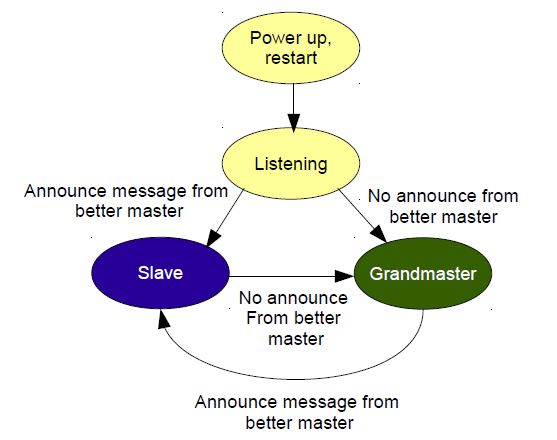| What Makes a Master the Best? | 您所在的位置:网站首页 › clock class › What Makes a Master the Best? |
What Makes a Master the Best?
|
What Makes a Master the Best? November 14, 2013 by Douglas Arnold 35 Comments Five Minute Facts About Packet Timing By Doug Arnold. This is a very brief introduction to the Best Master Clock Algorithm.聽 For a more detailed description refer to the more detailed post: BMCA Deep Dive. A key to the resiliency of the Precise Time Protocol is the Best Master Clock Algorithm, or BMCA. 聽The BMCA allows a clock to automatically take over the duties of Grandmaster when the previous Grandmaster loses its GPS, gets disconnected due to a switch fault, or for what ever reason is unable to continue as Grandmaster. To understand how this works consider a day in the life of an Ordinary Clock. 聽Recall from a previous post that an Ordinary Clock can be designed such that it is capable of acting as either a master or a slave. 聽The states that this clock can be in are shown in the state diagram below:
After power up the first thing the clock does is “listen”, in other words 聽it look for Announce messages from the PTP general multicast address. 聽An Announce message contains the properties of the clock which sent it. 聽If the Ordinary Clock sees an Announce message from a better clock it goes into a slave state, or passive if it is not slave capable. 聽If the Ordinary Clock does not see an Announce message from a better clock within the Announce Time Out Interval, then it takes over the role of Grandmaster. 聽This runs continuously so master capable devices are constantly on the look out for the possible loss of the current master clock. 聽For this reason it is critical that the Announce Time Out Interval be set longer than the Announce Interval in your network.聽 If you don’t then master capable devices will keep jumping to the conclusion that the master has gone away and they need to take over. 聽Its like a bunch of political pundits on a talk show who never listen and keep talking over each other. See also NTP vs PTP: Network Timing Smackdown!OK. So I have already used up two of my five minutes and I still haven’t told you what makes one master better than another. 聽Let’s get right to it. 聽The list below shows the criteria in order of precedence. Priority One Field: 聽This is an 8-bit user settable value. 聽The lowest number wins. 聽Normally this is set at 128 for master capable devices and 255 for slave only devices. 聽However, 聽if you want to overrule the normal selection criteria you can change Priority 1 and create any pecking order you wish.Clock Class: This is an enumerated list of clock states. 聽For example a clock with a GPS receiver locked to Universal Coordinated Time has more class than one which is free running and set by hand to your wrist watch. 聽There are also states for various levels of holdover when a clock which had a GPS receiver lost the connection.Clock Accuracy: This is an enumerated list of ranges of accuracy to UTC, for example 25-100 ns.Clock Variance: 聽This a complicated log scaled statistic which represents the jitter and wander of the clocks oscillator over a Sync message interval. 聽In fact it so complicated that if you can accurately determine it for a clock then you get three credits toward a degree in mathematics.Priority 2 Field: 聽You guessed it, another user settable field. 聽The main purpose at this low end of the decision tree is to allow system integrators to identify primary and backup clocks among identical redundant Grandmasters.Source Port ID: 聽This is a number which is required to be unique, and is usually set to the Ethernet MAC address. 聽Essentially this is a coin toss which is guaranteed to break a tie.See also The Sync Monitor reverse PTP mechanismOne last complication is Steps Removed. If two boundary clocks are getting their time from the same Grandmaster, then the one which is connected to the Grandmaster through fewer Boundary Clocks is better. 聽Transparent clocks don’t contribute to steps removed because they are, … well transparent. If you have any questions about PTP or hardware timestamping, don’t hesitate to send me an email at [email protected], or visit our website at www.meinbergglobal.com. share share share Related posts:BMCA Deep Dive: Part 2BMCA deep dive: part 1Using SNMP to Manage Network Time ServersWhat Are All Of These IEEE 1588 Clock Types? Previous Post - One-step or Two-step? Next Post - NTP vs PTP: Network Timing Smackdown!Filed Under: IEEE 1588 |
【本文地址】
